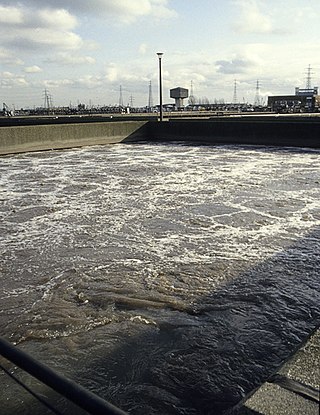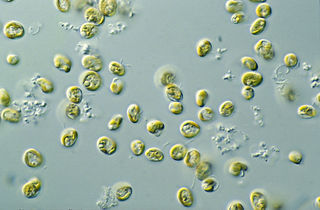
A bioreactor refers to any manufactured device or system that supports a biologically active environment. In one case, a bioreactor is a vessel in which a chemical process is carried out which involves organisms or biochemically active substances derived from such organisms. This process can either be aerobic or anaerobic. These bioreactors are commonly cylindrical, ranging in size from litres to cubic metres, and are often made of stainless steel. It may also refer to a device or system designed to grow cells or tissues in the context of cell culture. These devices are being developed for use in tissue engineering or biochemical/bioprocess engineering.

The activated sludgeprocess is a type of biological wastewater treatment process for treating sewage or industrial wastewaters using aeration and a biological floc composed of bacteria and protozoa. It uses air and microorganisms to biologically oxidize organic pollutants, producing a waste sludge containing the oxidized material.

Polyphosphate-accumulating organisms (PAOs) are a group of microorganisms that, under certain conditions, facilitate the removal of large amounts of phosphorus from their environments. The most studied example of this phenomenon is in polyphosphate-accumulating bacteria (PAB) found in a type of wastewater processing known as enhanced biological phosphorus removal (EBPR), however phosphate hyperaccumulation has been found to occur in other conditions such as soil and marine environments, as well as in non-bacterial organisms such as fungi and algae. PAOs accomplish this removal of phosphate by accumulating it within their cells as polyphosphate. PAOs are by no means the only microbes that can accumulate phosphate within their cells and in fact, the production of polyphosphate is a widespread ability among microbes. However, PAOs have many characteristics that other organisms that accumulate polyphosphate do not have that make them amenable to use in wastewater treatment. Specifically, in the case of classical PAOs, is the ability to consume simple carbon compounds without the presence of an external electron acceptor by generating energy from internally stored polyphosphate and glycogen. Most other bacteria cannot consume under these conditions and therefore PAOs gain a selective advantage within the mixed microbial community present in the activated sludge. Therefore, wastewater treatment plants that operate for enhanced biological phosphorus removal have an anaerobic tank prior to the other tanks to give PAOs preferential access to the simple carbon compounds in the wastewater that is influent to the plant.

Secondary treatment is the removal of biodegradable organic matter from sewage or similar kinds of wastewater. The aim is to achieve a certain degree of effluent quality in a sewage treatment plant suitable for the intended disposal or reuse option. A "primary treatment" step often precedes secondary treatment, whereby physical phase separation is used to remove settleable solids. During secondary treatment, biological processes are used to remove dissolved and suspended organic matter measured as biochemical oxygen demand (BOD). These processes are performed by microorganisms in a managed aerobic or anaerobic process depending on the treatment technology. Bacteria and protozoa consume biodegradable soluble organic contaminants while reproducing to form cells of biological solids. Secondary treatment is widely used in sewage treatment and is also applicable to many agricultural and industrial wastewaters.

The Nocardiaceae are a family of aerobic, non-fastidious, high G+C, Gram-positive actinomycetes that are commonly found in soil and water. Members of this family have been isolated from Antarctic soils. Nocardiaceae present coccobacilli, filamentous or, rarely, fragmented and palisading forms, and filamentous species grow in a branching morphological pattern similar to fungal hyphae.
Membrane bioreactors are combinations of some membrane processes like microfiltration or ultrafiltration with a biological wastewater treatment process, the activated sludge process. These technologies are now widely used for municipal and industrial wastewater treatment. The two basic membrane bioreactor configurations are the submerged membrane bioreactor and the side stream membrane bioreactor. In the submerged configuration, the membrane is located inside the biological reactor and submerged in the wastewater, while in a side stream membrane bioreactor, the membrane is located outside the reactor as an additional step after biological treatment.

An algae bioreactor is used for cultivating micro or macroalgae. Algae may be cultivated for the purposes of biomass production (as in a seaweed cultivator), wastewater treatment, CO2 fixation, or aquarium/pond filtration in the form of an algae scrubber. Algae bioreactors vary widely in design, falling broadly into two categories: open reactors and enclosed reactors. Open reactors are exposed to the atmosphere while enclosed reactors, also commonly called photobioreactors, are isolated to varying extents from the atmosphere. Specifically, algae bioreactors can be used to produce fuels such as biodiesel and bioethanol, to generate animal feed, or to reduce pollutants such as NOx and CO2 in flue gases of power plants. Fundamentally, this kind of bioreactor is based on the photosynthetic reaction, which is performed by the chlorophyll-containing algae itself using dissolved carbon dioxide and sunlight. The carbon dioxide is dispersed into the reactor fluid to make it accessible to the algae. The bioreactor has to be made out of transparent material.

A membrane is a selective barrier; it allows some things to pass through but stops others. Such things may be molecules, ions, or other small particles. Membranes can be generally classified into synthetic membranes and biological membranes. Biological membranes include cell membranes ; nuclear membranes, which cover a cell nucleus; and tissue membranes, such as mucosae and serosae. Synthetic membranes are made by humans for use in laboratories and industry.
Advenella faeciporci is a nitrite-denitrifying bacterium from the genus Advenella which was isolated from piggery wastewater.
Desulfovibrio paquesii is a bacterium. It is sulfate-reducing and hydrogenotrophic. The type strain is SB1(T).
Bacillus aerius is a species of bacteria first isolated from cryogenic tubes used for collecting air samples from high altitudes, hence its name. Its type strain is 24KT.
Sphingomonas rubra is a Gram-negative, rod-shaped, neutrophilic and motile bacteria from the genus of Sphingomonas which has been isolated from wastewater from a leather plant in China.
Gordonia humi is a Gram-positive and non-spore-forming bacterium from the genus Gordonia which has been isolated from soil near the mushroom Agaricus brasiliensis in Taiwan.
Gordonia jinhuaensis is a Gram-positive, aerobic, rod-shaped and non-motile bacterium from the genus Gordonia which has been isolated from pharmaceutical wastewater from Jinhua in China.
Gordonia malaquae is a bacterium from the genus Gordonia which has been isolated from sludge from a wastewater treatment plant in Taiwan.
Gordonia sihwensis is a Gram-positive and nitrate-reducing bacterium from the genus of Gordonia which has been isolated from an autotrophic denitrification reactor in Sihwa in Korea.
Sewer mining is a concept where municipal wastewater (sewage) is pumped from a trunk sewer and treated on-site to accommodate a range of local, nonpotable water needs. It is a strategy for combating water scarcity. It combines decentralized wastewater management and water reclamation. Since 2012, it is used as a tool for improving water management and promoting reuse of water in Australia.
Parapusillimonas is a genus of bacteria from the family of Alcaligenaceae with one known species.
Citricoccus zhacaiensis is a Gram-positive, neutrophilic, non-spore-forming and non-motile bacterium from the genus Citricoccus.






